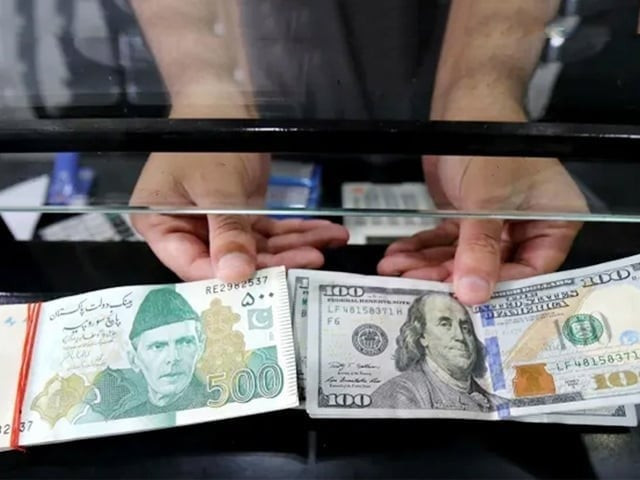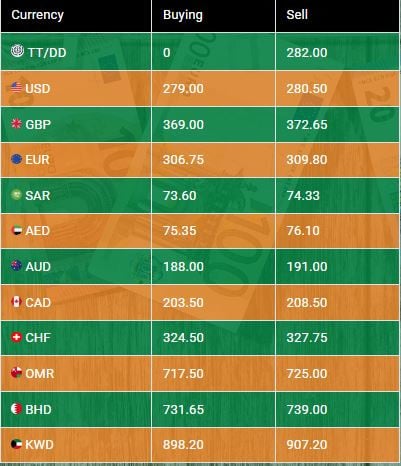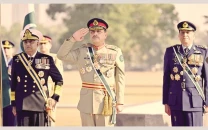USD exchange rates today: Rupee sustains minor losses
Pakistani rupee fluctuates as USD trades at Rs 279, GBP at Rs 369, and KWD reaches a high of Rs 907.20 in the market.

The currency exchange market saw varied movement on Tuesday, with the US dollar (USD) being bought at Rs 279.00 and sold at Rs 280.50.
On the other hand, the British pound (GBP) was being sold atRs 369.00 and selling ar Rs372.65,.
Meanwhile, the euro was being traded between Rs 306.75 and Rs 309.80.
Meanwhile, among the Gulf currencies, the Saudi riyal (SAR) was being bought at Rs 73.60 and sold at Rs 74.33, while the UAE dirham (AED) ranged from Rs 75.35 to Rs 76.10.
Other notable rates include, the Australian dollar (AUD) was being traded between Rs 188.00 and Rs 191.00, while the Canadian dollar (CAD) saw buying at Rs203.50 and selling at Rs 208.50, respectively.
Premium currencies such as the Omani rial, Bahraini dinar, and Kuwaiti dinar continued to hold their higher values.
The Omani rial (OMR) and Bahraini dinar (BHD) were among the highest-traded Gulf currencies, with OMR priced between Rs 717.50 and Rs 725.00 and BHD between Rs 731.65 and Rs 739.00.
Meanwhile, the Kuwaiti dinar (KWD) saw the highest value, trading between Rs 898.20 and Rs 907.20.
The Swiss franc maintained strength, with a buying rate of Rs 324.50 and a selling rate of Rs 327.75.

Photo: NBP Exchange Company Limited
Pakistan fluctuations in its exchange rate are influenced by several factors.
This mainly focuses on seven key variables, aside from the exchange rate itself.
These variables are exports, imports, stock price index, foreign reserves excluding gold, industrial production, wholesale price index, and money supply.
It is believed that these seven factors significantly impact the exchange rate.
Previously, Pakistani traders are increasingly turning to futures markets to exchange US dollars, earned through exports, for rupees, amid expectations that the domestic currency will further appreciate.
This comes ahead of the International Monetary Fund (IMF) Executive Board meeting, scheduled for September 25, to approve a $7 billion loan programme for Pakistan.
Speaking to The Express Tribune, Hassan Haider Naqvi, a senior analyst at Icon Management, said that the premium on the rupee-dollar exchange rate over the two-month forward counter dropped to Rs3.25/$, compared to Rs4-4.5/$ just days ago.
Exporters are offloading their dollar holdings to avoid potential losses as premiums continue to shrink.
Naqvi projected that the rupee could strengthen to Rs270-275/$ over the next couple of months, supported by a significant drop in global oil prices around $20 per barrel in recent weeks and expected inflows from the IMF once the new 37-month Extended Fund Facility (EFF) is approved.
He added that funds from other multilateral and bilateral creditors are also likely to be unlocked.
However, Naqvi noted that the sustainability of the rupee's gain remains uncertain, depending on future developments related to the IMF programme and global oil price trends.
He suggested that inflation reduction, the current account surplus, and the real effective exchange rate (REER) all indicate potential further appreciation of the rupee.
Nevertheless, he did not rule out a gradual return of pressure on the rupee, estimating it may settle between Rs270-280/$ by the end of December 2024.
Adnan Agar, Director of Interactive Commodities, said that the global demand for gold has increased following the US Federal Reserve's decision to cut interest rates by 50 basis points this week, double the expected 25 basis points.
"The steeper rate cut has greatly boosted gold prices," Agar noted.
He added that the escalation of geopolitical tensions in the Middle East, particularly with
Lebanon becoming involved in the conflict, has also supported gold prices.
Agar predicted a short-term correction of $80-100/ounce but said a rise above $2,700/ounce is not out of the question in the current gold boom cycle.
He cautioned that a larger correction of $500-600/ounce is overdue, as gold has surged to over $2,600/ounce from around $1,800/ounce a year ago.
Future gold price trends, Agar added, will depend on upcoming US job data and the US presidential election in November 2024.



















COMMENTS
Comments are moderated and generally will be posted if they are on-topic and not abusive.
For more information, please see our Comments FAQ